Abstract
Centenarians are an excellent model to study the relationship between the gut microbiome and longevity. To characterize the gut microbiome signatures of aging, we conducted a cross-sectional investigation of 1,575 individuals (20–117 years) from Guangxi province of China, including 297 centenarians (n = 45 with longitudinal sampling). Compared to their old adult counterparts, centenarians displayed youth-associated features in the gut microbiome characterized by an over-representation of a Bacteroides-dominated enterotype, increase in species evenness, enrichment of potentially beneficial Bacteroidetes and depletion of potential pathobionts. Health status stratification in older individuals did not alter the directional trends for these signature comparisons but revealed more apparent associations in less healthy individuals. Importantly, longitudinal analysis of centenarians across a 1.5-year period indicated that the youth-associated gut microbial signatures were enhanced with regard to increased evenness, reduction in interindividual variation and stability of Bacteroides, and that centenarians with low microbial evenness were prone to large microbiome instability during aging. These results together highlight a youth-related aging pattern of the gut microbiome for long-lived individuals.
This is a preview of subscription content, access via your institution
Access options
Subscribe to this journal
Receive 12 digital issues and online access to articles
118,99 € per year
only 9,92 € per issue
Rent or buy this article
Get just this article for as long as you need it
$39.95
Prices may be subject to local taxes which are calculated during checkout
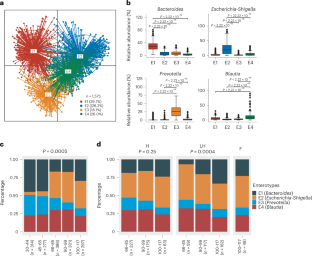
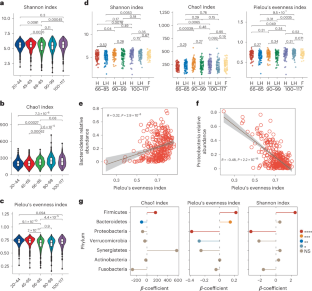
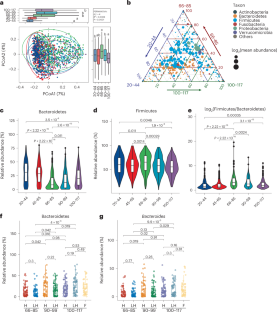
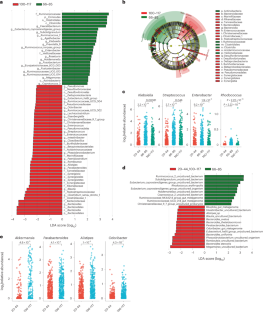
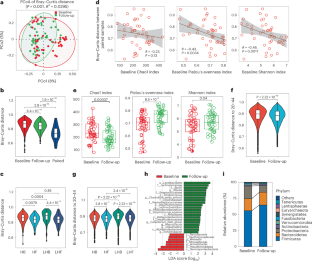

Data availability
Raw sequencing data were deposited in GenBank under accession no. PRJNA830660. Metadata information is available in Supplementary Tables 9 and 10. All other data are available from the corresponding authors upon reasonable request.
Code availability
The custom script for the prediction analysis is available at https://github.com/AIAGE-PROJECT/The-gut-microbiome-and-longevity-project-GMLP.
References
-
Dato, S. et al. The genetics of human longevity: an intricacy of genes, environment, culture and microbiome. Mech. Ageing Dev. 165, 147–155 (2017).
-
Cani, P. D. Human gut microbiome: hopes, threats and promises. Gut 67, 1716–1725 (2018).
-
de Vos, W. M., Tilg, H., Van Hul, M. & Cani, P. D. Gut microbiome and health: mechanistic insights. Gut 71, 1020–1032 (2022).
-
DeJong, E. N., Surette, M. G. & Bowdish, D. M. E. The gut microbiota and unhealthy aging: disentangling cause from consequence. Cell Host Microbe 28, 180–189 (2020).
-
Kim, S. & Jazwinski, S. M. The gut microbiota and healthy aging: a mini-review. Gerontology 64, 513–520 (2018).
-
Yatsunenko, T. et al. Human gut microbiome viewed across age and geography. Nature 486, 222–227 (2012).
-
Claesson, M. J. et al. Gut microbiota composition correlates with diet and health in the elderly. Nature 488, 178–184 (2012).
-
Biagi, E. et al. Gut microbiota and extreme longevity. Curr. Biol. 26, 1480–1485 (2016).
-
Kim, B.-S. et al. Comparison of the gut microbiota of centenarians in longevity villages of South Korea with those of other age groups. J. Microbiol. Biotechnol. 29, 429–440 (2019).
-
Wilmanski, T. et al. Gut microbiome pattern reflects healthy ageing and predicts survival in humans. Nat. Metab. 3, 274–286 (2021).
-
Ghosh, T. S., Shanahan, F. & O’Toole, P. W. The gut microbiome as a modulator of healthy ageing. Nat. Rev. Gastroenterol. Hepatol. 19, 565–584 (2022).
-
Larson, P. J. et al. Associations of the skin, oral and gut microbiome with aging, frailty and infection risk reservoirs in older adults. Nat. Aging 2, 941–955 (2022).
-
Puca, A. A., Spinelli, C., Accardi, G., Villa, F. & Caruso, C. Centenarians as a model to discover genetic and epigenetic signatures of healthy ageing. Mech. Ageing Dev. 174, 95–102 (2018).
-
Tavella, T. et al. Elevated gut microbiome abundance of Christensenellaceae, Porphyromonadaceae and Rikenellaceae is associated with reduced visceral adipose tissue and healthier metabolic profile in Italian elderly. Gut Microbes 13, 1–19 (2021).
-
Zhang, S. et al. Gut microbiota in healthy and unhealthy long-living people. Gene 779, 145510 (2021).
-
Rampelli, S. et al. Shotgun metagenomics of gut microbiota in humans with up to extreme longevity and the increasing role of xenobiotic degradation. mSystems 5, e00124-20 (2020).
-
Sato, Y. et al. Novel bile acid biosynthetic pathways are enriched in the microbiome of centenarians. Nature 599, 458–464 (2021).
-
Ren, M., Li, H., Fu, Z. & Li, Q. Succession analysis of gut microbiota structure of participants from long-lived families in Hechi, Guangxi, China. Microorganisms 9, 2524 (2021).
-
Wu, L. et al. A cross-sectional study of compositional and functional profiles of gut microbiota in Sardinian centenarians. mSystems 4, e00325-19. (2019).
-
Chen, L. et al. The long-term genetic stability and individual specificity of the human gut microbiome. Cell 184, 2302–2315 (2021).
-
Costea, P. I. et al. Enterotypes in the landscape of gut microbial community composition. Nat. Microbiol. 3, 8–16 (2018).
-
McCoubrey, L. E., Gaisford, S., Orlu, M. & Basit, A. W. Predicting drug–microbiome interactions with machine learning. Biotechnol. Adv. 54, 107797 (2022).
-
Arumugam, M. et al. Enterotypes of the human gut microbiome. Nature 473, 174–180 (2011).
-
Gauffin Cano, P., Santacruz, A., Moya, Á. & Sanz, Y. Bacteroides uniformis CECT 7771 ameliorates metabolic and immunological dysfunction in mice with high-fat-diet induced obesity. PLoS ONE 7, e41079 (2012).
-
Brown, E. M. et al. Bacteroides-derived sphingolipids are critical for maintaining intestinal homeostasis and symbiosis. Cell Host Microbe 25, 668–680 (2019).
-
Kelly, D. et al. Commensal anaerobic gut bacteria attenuate inflammation by regulating nuclear-cytoplasmic shuttling of PPAR-γ and RelA. Nat. Immunol. 5, 104–112 (2004).
-
Tan, H., Zhai, Q. & Chen, W. Investigations of Bacteroides spp. towards next-generation probiotics. Food Res. Int. 116, 637–644 (2019).
-
Tan, H., Zhao, J., Zhang, H., Zhai, Q. & Chen, W. Novel strains of Bacteroides fragilis and Bacteroides ovatus alleviate the LPS-induced inflammation in mice. Appl. Microbiol. Biotechnol. 103, 2353–2365 (2019).
-
Wang, K. et al. Parabacteroides distasonis alleviates obesity and metabolic dysfunctions via production of succinate and secondary bile acids. Cell Rep. 26, 222–235 (2019).
-
Parker, B. J., Wearsch, P. A., Veloo, A. C. M. & Rodriguez-Palacios, A. The genus Alistipes: gut bacteria with emerging implications to inflammation, cancer, and mental health. Front. Immunol. 11, 906 (2020).
-
Huber-Ruano, I. et al. Orally administered Odoribacter laneus improves glucose control and inflammatory profile in obese mice by depleting circulating succinate. Microbiome 10, 135 (2022).
-
Kong, F., Deng, F., Li, Y. & Zhao, J. Identification of gut microbiome signatures associated with longevity provides a promising modulation target for healthy aging. Gut Microbes 10, 210–215 (2019).
-
Biagi, E. et al. The gut microbiota of centenarians: signatures of longevity in the gut microbiota profile. Mech. Ageing Dev. 165, 180–184 (2017).
-
Costea, P. I. et al. Enterotypes in the landscape of gut microbial community composition. Nat. Microbiol. 3, 8–16 (2018).
-
Cheng, M. & Ning, K. Stereotypes about enterotype: the old and new ideas. Genomics Proteomics Bioinformatics 17, 4–12 (2019).
-
Zhong, H. et al. Impact of early events and lifestyle on the gut microbiota and metabolic phenotypes in young school-age children. Microbiome 7, 2 (2019).
-
Xiao, L., Wang, J., Zheng, J., Li, X. & Zhao, F. Deterministic transition of enterotypes shapes the infant gut microbiome at an early age. Genome Biol. 22, 243 (2021).
-
Jeffery, I. B., Lynch, D. B. & O’Toole, P. W. Composition and temporal stability of the gut microbiota in older persons. ISME J. 10, 170–182 (2016).
-
Biagi, E. et al. Through ageing, and beyond: gut microbiota and inflammatory status in seniors and centenarians. PLoS ONE 5, e10667 (2010).
-
Li, C. et al. Deep insights into the gut microbial community of extreme longevity in south Chinese centenarians by ultra-deep metagenomics and large-scale culturomics. NPJ Biofilms Microbiomes 8, 28 (2022).
-
O’Toole, P. W. & Jeffery, I. B. Gut microbiota and aging. Science 350, 1214–1215 (2015).
-
Jeffery, I. B. & O’Toole, P. W. Diet-microbiota interactions and their implications for healthy living. Nutrients 5, 234–252 (2013).
-
Hiippala, K. et al. Isolation of anti-inflammatory and epithelium reinforcing Bacteroides and Parabacteroides spp. from a healthy fecal donor. Nutrients 12, 935 (2020).
-
Raftar, S. K. A. et al. The anti-inflammatory effects of Akkermansia muciniphila and its derivates in HFD/CCL4-induced murine model of liver injury. Sci. Rep. 12, 2453 (2022).
-
Deng, F., Li, Y. & Zhao, J. The gut microbiome of healthy long-living people. Aging 11, 289–290 (2019).
-
Zafar, H. & Saier, M. H. Jr. Gut species in health and disease. Gut Microbes 13, 1–20 (2021).
-
Cani, P. D. & Knauf, C. A newly identified protein from Akkermansia muciniphila stimulates GLP-1 secretion. Cell Metab. 33, 1073–1075 (2021).
-
Hirata, T. Associations of cardiovascular biomarkers and plasma albumin with exceptional survival to the highest ages. Nat. Commun. 11, 3820 (2020).
-
Anderson, E. L. et al. A robust ambient temperature collection and stabilization strategy: enabling worldwide functional studies of the human microbiome. Sci. Rep. 6, 31731 (2016).
-
Peel, C. et al. Assessing mobility in older adults: the UAB Study of Aging Life-Space Assessment. Phys. Ther. 85, 1008–1119 (2005).
-
Mackey, D. C. et al. Life-space mobility and mortality in older men: a prospective cohort study. J. Am. Geriatr. Soc. 62, 1288–1296 (2014).
-
Chitalu, P., Tsui, A., Searle, S. D. & Davis, D. Life–space, frailty, and health-related quality of life. BMC Geriatr. 22, 646 (2022).
-
Bolyen, E. et al. Reproducible, interactive, scalable and extensible microbiome data science using QIIME 2. Nat. Biotechnol. 37, 852–857 (2019).
-
Callahan, B. J. et al. DADA2: high-resolution sample inference from Illumina amplicon data. Nat. Methods 13, 581–583 (2016).
-
Bokulich, N. A. et al. Optimizing taxonomic classification of marker-gene amplicon sequences with QIIME 2’s q2-feature-classifier plugin. Microbiome 6, 90 (2018).
-
Allard, G., Ryan, F. J., Jeffery, I. B. & Claesson, M. J. SPINGO: a rapid species-classifier for microbial amplicon sequences. BMC Bioinformatics 16, 324 (2015).
-
McMurdie, P. J. & Holmes, S. phyloseq: an R package for reproducible interactive analysis and graphics of microbiome census data. PLoS ONE 8, e61217 (2013).
-
Shi, Y., Zhang, L., Do, K.-A., Peterson, C. B. & Jenq, R. R. aPCoA: covariate adjusted principal coordinates analysis. Bioinformatics 36, 4099–4101 (2020).
-
Segata, N. et al. Metagenomic biomarker discovery and explanation. Genome Biol. 12, R60 (2011).
-
Holmes, I., Harris, K. & Quince, C. Dirichlet multinomial mixtures: generative models for microbial metagenomics. PLoS ONE 7, e30126 (2012).
-
Thioulouse, J. et al. Multivariate Analysis of Ecological Data with ade4 (Springer, 2018).
-
Feng, Q. et al. Gut microbiome development along the colorectal adenoma-carcinoma sequence. Nat. Commun. 6, 6528 (2015).
Acknowledgements
This work was supported by funding and grants for Xiaochun Chen and Xiaodong Chen from the Nanning New Industry Research Institute for Longevity Technology and from the Science and Technology Base Special Project (no. 20201080) and for W.L. from the Special Project to Guide Technological Innovation of the Science and Technology Bureau of Nanning City (no. RC20212301).
Author information
Authors and Affiliations
Contributions
S.W. and W.L. conceived and supervised the project. S.W., W.L., S.P., P.Y., Xiaochun Chen and Z.L. designed and performed the data analysis. L.M., X.Y., L.H. and W.L. performed the library construction and 16S rRNA sequencing. Xiaodong Chen, Y.H., S.W. and W.L. collected the fecal samples and health information from each participant. S.W., W.L. and S.P. wrote the manuscript; J.L. and T.P. participated in study design, safety review and discussion. All authors discussed the results and read the manuscript.
Corresponding authors
Ethics declarations
Competing interests
W.L., S.P., Xiaodong Chen, L.M., Y.H., X.Y., L.H., P.Y. and Xiaochun Chen are employees of the AIage Life Science Corporation. The AIage Life Science Corporation partially funded this research. The Guangxi Free Trade Zone Aisheng Biotechnology Corporation is a subsidiary of the AIage Life Science Corporation. The funders had no role in study design, data collection and analysis, decision to publish or preparation of the manuscript. The other authors declare no competing interests.
Peer review
Peer review information
Nature Aging thanks the anonymous reviewers for their contribution to the peer review of this work.
Additional information
Publisher’s note Springer Nature remains neutral with regard to jurisdictional claims in published maps and institutional affiliations.
Extended data
Extended Data Fig. 1 There was no significant difference in terms of microbial community structure between males and females in the centenarian group.
Comparison of the microbial α-diversity, including the Chao1 index (a), Pielou’s index (b) and Shannon index (c), between female (n = 229) and male (n = 68) centenarians (two-sided Wilcoxon rank-sum test). (d) β-Diversity was calculated using Bray‒Curtis distance and is shown by PCoA plot (Adonis test, P = 0.487, R2 = 0.0033). Data in boxes with no common letters are significantly different in one-way ANOVA with Tukey post hoc test (two-sided, P < 0.05). Boxes in boxplots represent the 25th percentile, median, and 75th percentile and whiskers stretch to 1.5 times the interquartile range from the corresponding hinge.
Extended Data Fig. 2 PCoA for the gut microbiome based on Bray‒Curtis distance.
The gut microbiota compositions of centenarians who had/did not have a recorded high blood pressure (a) (Yes, n = 110; No, n = 186), body mass index (b) (BMI ≥ 24, n = 6; 18.5 ≤ BMI ≤ 23.9, n = 168; BMI ˂ 18.5, n = 123), alcohol drinking (c) (Yes, n = 25; No, n = 266) or tea drinking (d) (Yes, n = 18; No, n = 279) were analyzed. These variations among individuals were not associated with any clear separation of the gut microbiome. The Adonis test and one-way ANOVA with Tukey’s post hoc test were used for all panels. Data in boxes with no common letters are significantly different in one-way ANOVA with Tukey post hoc test (two-sided, P < 0.05). Boxes in boxplots represent the 25th percentile, median, and 75th percentile and whiskers stretch to 1.5 times the interquartile range from the corresponding hinge.
Extended Data Fig. 3 The identified enterotypes for all the samples.
(a) Laplace approximation for the Dirichlet multinomial mixtures (DMM) protocol indicated that the optimal number of clusters was 4 in the cohorts. The top 20 drivers of enterotype 1 (b), enterotype 2 (c), enterotype 3 (d) and enterotype 4 (e) in the cohorts are listed. The values of the x-coordinate indicate the contribution of each variable to the enterotype in between-class analysis (BCA).
Extended Data Fig. 4 PCoA of weighted or unweighted UniFrac distances.
Variation in gut microbial community structure among groups (n = 1575) represented by PCoA plots based on unweighted UniFrac distance (a) and weighted UniFrac distance (b). The Adonis test and one-way ANOVA with Tukey’s post hoc test were used for all panels. Data in boxes with no common letters are significantly different in one-way ANOVA with Tukey post hoc test (two-sided, P < 0.05). Boxes in boxplots represent the 25th percentile, median, and 75th percentile and whiskers stretch to 1.5 times the interquartile range from the corresponding hinge.
Extended Data Fig. 5 LEfSe results for different comparisons.
(a) Differentially abundant taxa between the old adult group and the combined non-old-adult group (20-44 and 100-117 years, including the young group and the centenarian group as subclasses in LEfSe; Kruskal‒Wallis test between classes, Wilcoxon rank-sum test between subclasses, P < 0.05, LDA > 2). (b) Differentially abundant taxa between the young group and the centenarian group (Kruskal‒Wallis test between classes; P < 0.05, LDA > 2). (c) Differentially abundant species determined by SPINGO analysis between the old adult group and the combined non-old-adult group (young group and centenarian group; Kruskal‒Wallis test between classes, Wilcoxon rank-sum test between subclasses, P < 0.05, LDA > 2). All statistical testes used were two-sided.
Extended Data Fig. 6 LEfSe results between the old adult group and the centenarian group under health status stratifications.
(a) LEfSe results in healthy (H; n = 63) centenarians and healthy old adults (n = 60) (P < 0.05, LDA > 2). (b) LEfSe results in less healthy (LH) centenarians (n = 60) and less healthy old adults (n = 59) (P < 0.05, LDA > 2). Kruskal‒Wallis test between classes and Wilcoxon rank-sum test between subclasses were used (two-sided).
Extended Data Fig. 7 Comparisons of microbial compositions between baseline and follow-up.
(a) aPCoA of the Bray‒Curtis distance plot for baseline and follow-up after adjusting for hypertension, medication use, and alcohol and tea drinking. (b) α-Diversity differences between baseline and follow-up for stratified health statuses (HB, n = 21; HF, n = 15; LHB, n = 19; LHF, n = 27). (c) Composition of the gut microbiome at the phylum level between baseline and follow-up for stratified health statuses. (d) LEfSe between baseline and follow-up stratified by health status (two-sided Kruskal‒Wallis test between classes; P < 0.05, LDA > 2). Healthy baseline (HB, n = 21), healthy follow-up (HF, n = 15), less healthy baseline (LHB, n = 19) and less healthy follow-up (LHF, n = 27) samples were examined. The Wilcoxon rank-sum test (two-sided) was used for panel b. Boxes in boxplots represent the 25th percentile, median, and 75th percentile and whiskers stretch to 1.5 times the interquartile range from the corresponding hinge.
Extended Data Fig. 8 Cross-sectional comparison of the taxa with differential abundances in the longitudinal (follow-up) analysis.
In old adults (age 66-85 years, n = 386), Weissella, Streptococcus and Clostridium sensu stricto 1 were enriched, but Lachnoclostridium, Phascolarctobacterium and Blautia were less abundant than those in young adults (age 20-44 years, n = 314). The Wilcoxon rank-sum test (two-sided) was used. Box plots show the median and upper and lower quartiles, and whiskers extend to 1.5 times the interquartile range.
Extended Data Fig. 9 The gut microbial markers identified by random forest analysis to differentiate centenarian individuals (n = 297) and non-centenarian individuals (n = 700).
The Wilcoxon rank-sum test (two-sided) was used. Boxes in boxplots represent the 25th percentile, median, and 75th percentile and whiskers stretch to 1.5 times the interquartile range from the corresponding hinge.
Extended Data Fig. 10 Rarefaction curves for 16S rRNA sequencing.
The estimated ASV richness approached saturation in the samples of cross-sectional cohorts (a) and longitudinal cohorts (follow-up analysis) (b).
Supplementary information
Rights and permissions
Springer Nature or its licensor (e.g. a society or other partner) holds exclusive rights to this article under a publishing agreement with the author(s) or other rightsholder(s); author self-archiving of the accepted manuscript version of this article is solely governed by the terms of such publishing agreement and applicable law.
About this article
Cite this article
Pang, S., Chen, X., Lu, Z. et al. Longevity of centenarians is reflected by the gut microbiome with youth-associated signatures. Nat Aging (2023). https://ift.tt/W6MOGrk
-
Received:
-
Accepted:
-
Published:
-
DOI: https://ift.tt/W6MOGrk
Health - Latest - Google News
April 06, 2023 at 10:20PM
https://ift.tt/r4nNGz0
Longevity of centenarians is reflected by the gut microbiome with youth-associated signatures - Nature.com
Health - Latest - Google News
https://ift.tt/xnBX7Di
Bagikan Berita Ini














0 Response to "Longevity of centenarians is reflected by the gut microbiome with youth-associated signatures - Nature.com"
Post a Comment